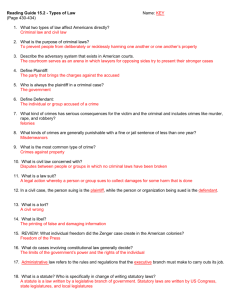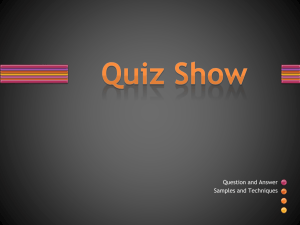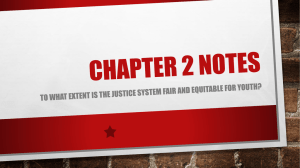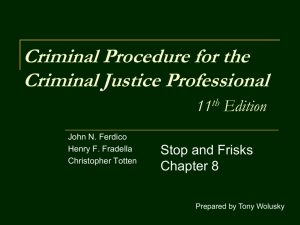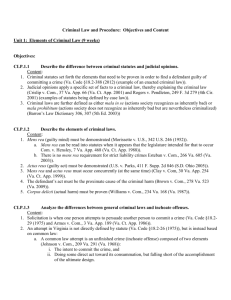Constitutional & Criminal Law
advertisement
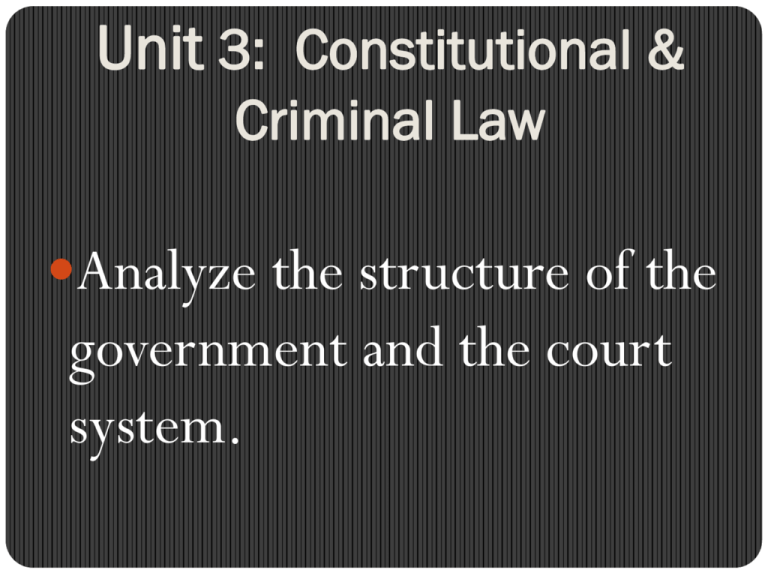
Unit 3: Constitutional & Criminal Law Analyze the structure of the government and the court system. Constitutional & Criminal Law Identify criminal laws used frequently in the criminal justice system Essential Questions Can I get into trouble for that? Can the police really do that? Criminal Law • formal means of social control that uses rules • interpreted and enforced by the courts • to set limits to the conduct of the citizens • to guide the officials • to define unacceptable behavior”. Penal Code The criminal law of a political jurisdiction. Civil Law a means of resolving conflicts between individuals Tort A violation of the civil law. Substantive Law The body of law that defines criminal offenses and their penalties. Procedural Law The body of law that governs the ways substantive laws are administered Due Process of Law The rights of people suspected of or charged with crimes. 1. Politicality Rules made by the state (only these are crimes) 2. Specificity Strict definitions of specific acts 3. Regularity Applied to all persons, regardless of social status 4. Uniformity Enforcement of the laws against anyone who violates them, regardless of social status 5. Penal Sanction Violators will be punished by the state (or at least threatened with punishment) Precedent A decision of a court that forms a potential basis for deciding the outcomes of similar cases in the future. Searches Explorations or inspections by law enforcement officers of homes, property, vehicles, or persons to discover evidence of crimes or persons who are accused of crimes. Seizures Take persons or property into custody in response to violations of the criminal law. Warrant A written order from a court directing LEO to conduct a search or to arrest a person. Arrest The seizure of a person or the taking of a person into custody Actual physical custody: suspect is handcuffed by a police officer Constructive custody: person peacefully submits to a police officer’s control Contraband An illegal substance or object. Standards of Proof There are 7 1. Mere suspicion Very little certainty, “gut feeling” Cannot legally stop a suspect 2. Reasonable Suspicion Can put reasons for suspicion into words Needed to stop and frisk 3. Probable Cause Reasonably intelligent person could believe Crime committed or Evidence can be found 3. Probable Cause What you need to conduct a search or make an arrest 4. Preponderance of evidence Sufficient evidence to overcome doubt or speculation Needed to find defendant liable in civil suit (think OJ) 4. Preponderance of evidence also needed for: Inevitable discovery rule: we would have found it anyway Waiver of right to counsel was done knowingly 5. Clear and convincing evidence Needed to make a successful claim of insanity in a federal case 6. Beyond a Reasonable Doubt Needed to find a defendant guilty in a criminal trial 7. Certainty You don’t need to write this one. It is rarely achieved in criminal justice. Frisking Conducting a search for weapons by patting the outside of a suspect’s clothing, feeling for objects that might be weapons. Exclusionary Rule The rule that illegally seized evidence must be excluded from trials in federal courts. Double Jeopardy The trying of a defendant a second time for the same offense. Self-incrimination Being a witness against oneself. If forced, it is a violation of the Fifth Amendment. Confession An admission by a person accused of a crime that he or she committed the offense charged. Venue The place of the trial. It must be geographically appropriate. Subpoena Written order that requires a person to appear to give testimony. Or records/objects be made available for examination.
